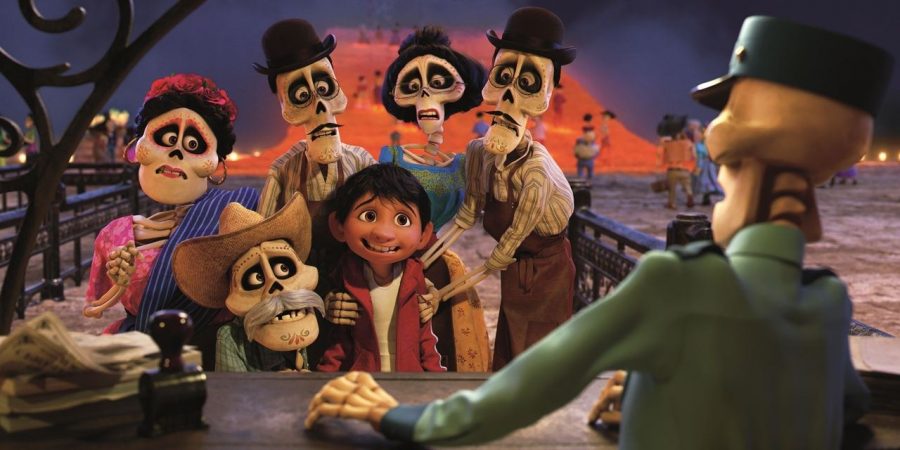Pixar’s Coco is surrounded by worry
Copyright issues and copycat claims lead to controversy
December 13, 2017
Pixar’s latest film, “Coco,” has recently hit theaters. It has been met with stupendous praise from critics, a fact that subverts the sordid, controversial, and confusing history of the film’s development.
In May 2017, the first teaser for Coco was released. Though no one could deny that the film looked beautifully animated and fun, fans took to social media and criticized Disney for ripping off another film released by Reel FX Creative Studios in 2014, “The Book of Life.”
Both films focus on El Día de Los Muertos (In English: The Day of the Dead), a Mexican holiday during which the spirits of the deceased return to being with their living families. The protagonists of both films aspire to be musicians but meet opposition from their families who want them to stay in line with family tradition (Bullfighting in The Book of Life and shoemaking in Coco).
Jorge R. Gutierrez, director, and writer of The Book of Life struggled to get the project up and running after being turned down by Pixar. Despite this and despite not being a part of a particularly well-known company, he was dedicated to producing a film that shed light on an important aspect of his own culture and did so with beautiful visuals. Fans of The Book of Life often celebrate the fact that Gutierrez ensured that the original character designs in The Book of Life artbook transferred over into the final film. Normally, artbook designs for animated filmed are conceptual and are made less complex at some point in development. Retaining the original designs would make for much harder animation, but a better visual product in the end.
Meanwhile, Disney is a huge corporation with resources and money enough to do whatever they want with their films. Notably, the director of Coco, Lee Unkrich, has no Mexican heritage. If Disney did rip off The Book of Life, it would be a tasteless case of the big and powerful treading over the small and weak.
Early in Coco’s development, there was also a rumor that Gutierrez had gone to Disney with his pitch for The Book of Life and had been turned down. This rumor was eventually proven false– fans were confusing Disney with Dreamworks– but nevertheless lead to further controversy.
With all that said, it is rather unlikely that Disney intentionally copied from The Book of Life.
The original pitch for Coco was made just after the release of Toy Story 3 in 2010. It was first announced, still under the working title of “Día de Los Muertos,” in early 2012; The Book of Life entered production in late 2012.
But that is not where the controversy ends: the original name for the film led to more problems. On May 1st, 2013, the Walt Disney Company attempted to copyright the name of the film. Since the title at the time was “Día de Los Muertos,” this, understandably, lead to outrage from the Mexican community, particularly activist groups, who accused Disney of appropriating an important part of their culture and using it for profit. Even worse, copyright laws would allow Disney to sue others for the use of the holiday’s name. A week later, Disney retracted their copyright attempts and decided to change the title of the film.
Unlike the controversy over the originality of ideas, which was understandable but could be refuted, this was a more straight-forward mistake on Disney’s part. However, the company did try to make up for it: they hired Lalo Alcaraz, one of the most vocal whistleblowers during the copyright scandal and the creator of the Disney-criticizing editorial cartoon “Muerto Mouse,” as a cultural consultant for the film. At the very least, this shows that Disney was willing to improve from their mistakes, though some could argue that this movie was made to prevent further backlash.
Regardless, Coco is out in theaters, and the reviews are absolutely glowing– Disney’s choice to hire Alcaraz seems to have paid off, and the film, of course, has all of Disney’s usual fantastic comedy, characterization, and tearjerker moments. When asked if the film accurately represented her culture, junior Janet Lovera said, “I believe that it does do a good job, especially in showing a very important part of the Mexican culture, which is El Día De Los Muertos. It expands and explains this idea in a way that is easy to understand and is entertaining. Coco does a better job of portraying this within the plot and making family, which is a prominent aspect of Mexican culture, one of the central themes.”
In the slew of positive reviews and negative scandals, it is important for one to go and see the film to draw conclusions, but it is important that one does as Disney did after the copyright scandal: when new films, books, or games come out that attempt to represent a particular culture, listen to the members of that culture. It’s the least one can do.



